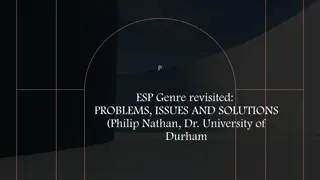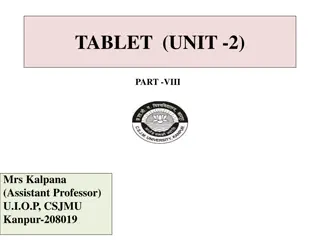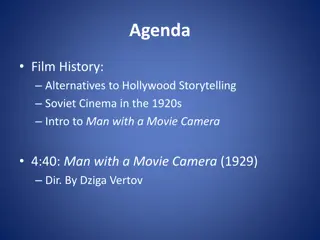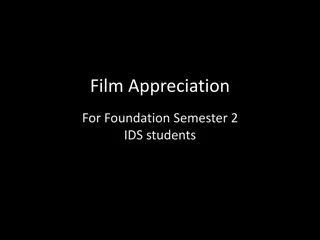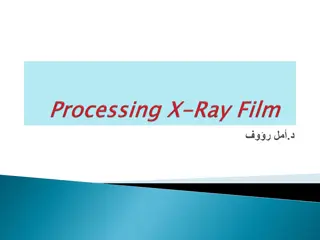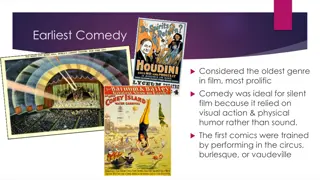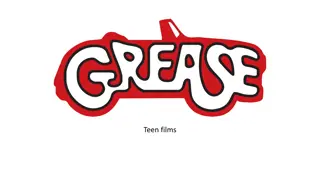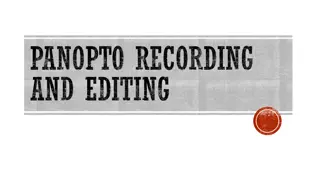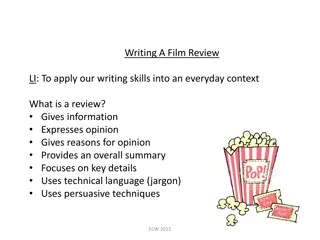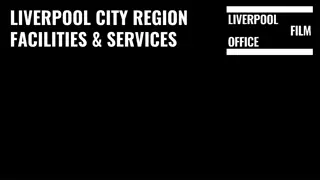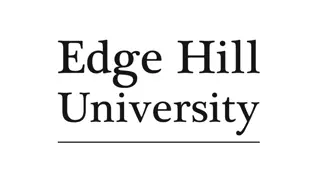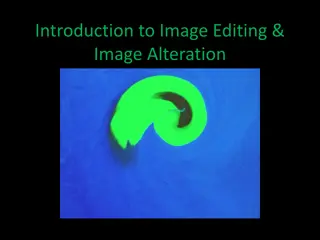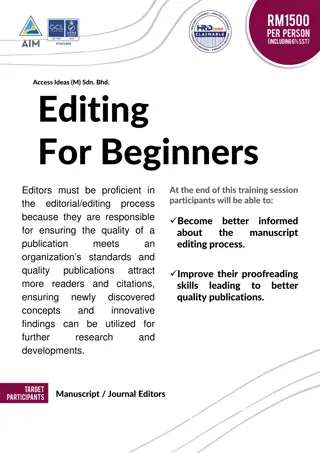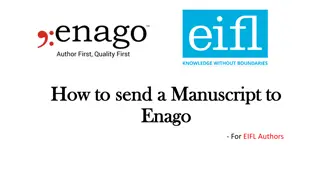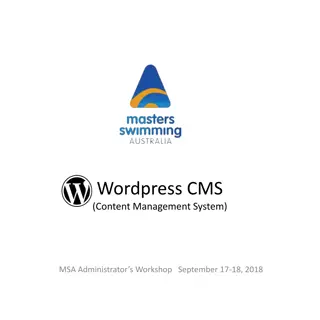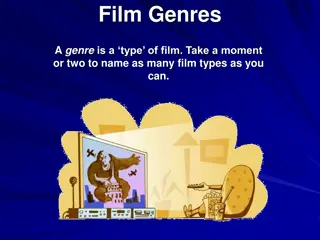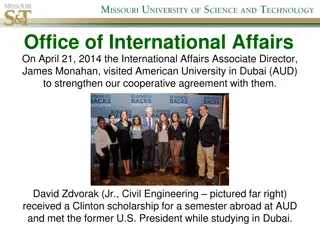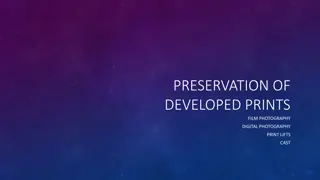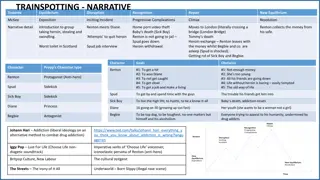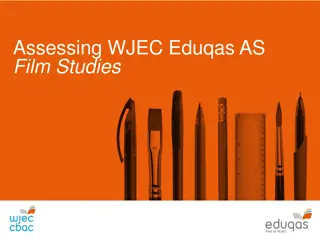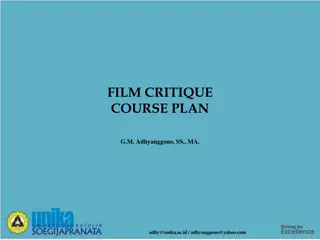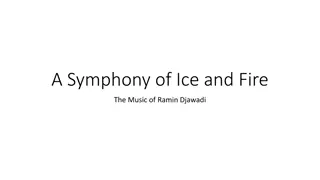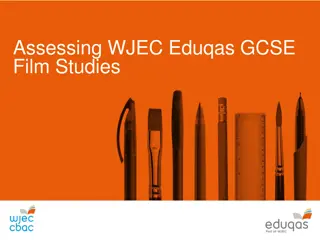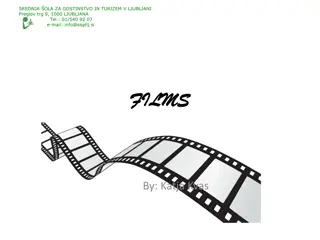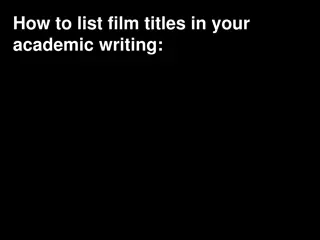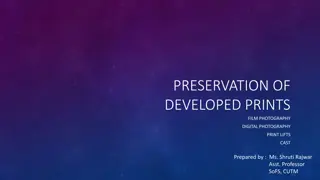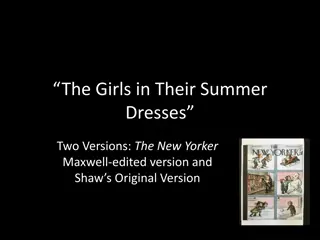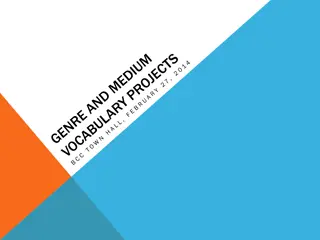Film Studies Agenda for 4/9: Montage Editing, Odessa Steps Analysis, and Genre Discussion
Explore key topics in film studies such as montage editing, analysis of the Odessa Steps sequence, and discussions on film genres, classical Hollywood narrative, French Impressionism, and German Expressionism.
Download Presentation

Please find below an Image/Link to download the presentation.
The content on the website is provided AS IS for your information and personal use only. It may not be sold, licensed, or shared on other websites without obtaining consent from the author. Download presentation by click this link. If you encounter any issues during the download, it is possible that the publisher has removed the file from their server.
E N D
Presentation Transcript
Agenda for 4/9 Quiz #1 Man with a Movie Camera discussion Montage Editing lecture Break Odessa Steps and analysis Film and Ideology discussion What is Genre?
Man with a Movie Camera What did you draw in your picture? Is there a story in this film? What does the film tell you about life in the Soviet Union in the 1920s? Why does Vertov show us his filmmaking process at various points in the film? Why watch experimental film? What are the strategies for drawing meaning from it?
Formal Approaches to Movie Meaning-Making How do you use film to: Tell a story (in a way that a novel or a play can t)? Convey the complex inner thoughts and intentions of the people on screen? Make viewers in the audience feel strong emotions, or think new ideas, or see the world in a different way?
Classical Hollywood Narrative: Continuity and Clarity
Cinematographic Distortion: French Impressionism
Distortion of Mise-en-scene: German Expressionism
Sharp Juxtapositions in Editing: Soviet Montage
Continuity Editing Associated with D.W. Griffith The convention of classical Hollywood filmmaking. Meant to be essentially invisible to the viewer. Cause and Effect Editing: A B C Parallel Editing or Cross-Cutting: A + B = C
Aspects of Continuity Editing Shot-to-Shot Matches Eyeline match Match-on-action Graphic match Spatial Consistency Master scenes Establishing shot 180-degree rule Temporal Consistency Linear progression of time and event
Montage (or disjunctive) Editing Associated with Sergei Eisenstein and Soviet Cinema of the 20s. Meant to call attention to the editing itself: Andre Bazin: The creation of a sense of meaning not proper to the images themselves but derived exclusively from their juxtaposition (LaM 349) A + B = Z (where Z is something offscreen that we, the viewer, have to imagine or think or feel)
Some Aspects of Montage Editing Tempo: Use of different shot lengths (very fast cuts, for example) to create a feeling (like tension) Vectors: Using contrasting angles and movements to convey a feeling (like confusion) Repetition: Using the same or very similar shots multiple times in a sequence Fragmentation: Breaking a simple action into several different shots Dramatic Juxtaposition: Mixing related by not directly connected images (as in a reaction shot ) Visual Metaphor: Adding unrelated images to a sequence to create a metaphoric association
Montage Editing In Man with a Movie Camera Graphic Matches to Draw Unusual Connections i.e., woman washing face / someone washing the city street Man mining coal / industrial stack producing smoke Fast Tempo: Average shot length of movies made in 1929: 11.2 seconds. Average shot length of Man with a Movie Camera: 2.3 seconds Use of Still Images Crowd Movements http://www.theasc.com/blog/2014/01/13/the-spinning-top-and-the-parvo-man-with-a-movie-camera/
Odessa Steps Sequence From Sergei Eisenstein s Battleship Potemkin (1925) Watch for: Sharp juxtapositions between shots Mix of crowd and individual shots Tempo of shots Directionality and angles of movement
Film and Ideology What s ideology? How do films transmit ideology? How do you determine a film s ideology? The same commercial instinct that inspires filmmakers to use seamless continuity also compels them to favor stories that reinforce viewers shared belief systems . . . Because so much of this occurs on an unconscious, emotional level, the casual viewer may be blind to [a film s] implied political, cultural, and ideological messages (LaM 10) What is Sherlock Jr. s ideology? What is Man with a Movie Camera s?
Next Week: Singin in the Rain (1952) Read chapter 4 (on narratives) and pages 450- 455 First blog post due at the end of next week (Friday 4/18). I ll talk about the shot list/essay assignment due at the end of Week 4 (Friday, 4/25)



